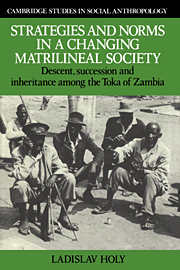 Strategies and Norms in a Changing Matrilineal Society
Strategies and Norms in a Changing Matrilineal Society Published online by Cambridge University Press: 25 August 2009
The emergence of the other two villages in Guta illustrates further the principles of village fission discussed in Chapter 1.
Kataba (Diagram 3)
Kataba's mother's brother, Kamela (G2), was dead in 1935 when Kamenyani (H15) moved his village from Guta to Nyawa. Kataba (H5) was thus the senior male member of Mukasilumbe's (F1) mukowa. Like Kamenyani (H15) and Matongo (H12), Kataba (H5) is a son of Lunga's sister's daughter. When Kamenyani (H15) succeeded to Lunga's headmanship, Kataba (H5) exercised his right to become a village headman by forming a village of his own; if he had stayed in the village of which Matongo (H12) became a headman, this would have amounted to recognising Kamenyani's and Matongo's right to headmanship and forfeiting his own. Unlike Matongo (H12), however, Kataba (H5) did not command the wide support of his basimukowa and their children nor the support of his own children. Of the members of his own mukowa, he attracted only his uterine sister, Bene (H3), to his own village. Nowadays Bene's son, Siyamonga (I4), and the latter's son, Alec (J2), live with their families in Kataba's village.
Most of the village inhabitants are members of the Muntanga clan. They are kinsmen of Kataba's first wife, Muntemba (I5), who is herself a member of this clan, and they were attracted to the village because of their relationship to her.
To save this book to your Kindle, first ensure [email protected] is added to your Approved Personal Document E-mail List under your Personal Document Settings on the Manage Your Content and Devices page of your Amazon account. Then enter the ‘name’ part of your Kindle email address below. Find out more about saving to your Kindle.
Note you can select to save to either the @free.kindle.com or @kindle.com variations. ‘@free.kindle.com’ emails are free but can only be saved to your device when it is connected to wi-fi. ‘@kindle.com’ emails can be delivered even when you are not connected to wi-fi, but note that service fees apply.
Find out more about the Kindle Personal Document Service.
To save content items to your account, please confirm that you agree to abide by our usage policies. If this is the first time you use this feature, you will be asked to authorise Cambridge Core to connect with your account. Find out more about saving content to Dropbox.
To save content items to your account, please confirm that you agree to abide by our usage policies. If this is the first time you use this feature, you will be asked to authorise Cambridge Core to connect with your account. Find out more about saving content to Google Drive.